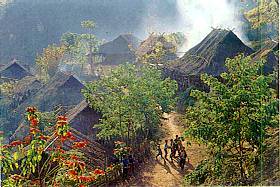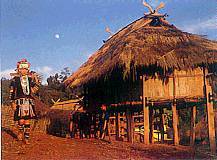
Window to Chiang Mai Thailand

Window to Chiang Mai Thailand
Elephant Care & Trekking Tours
 Here are six main hilltribes found in Northern Thailand. Each tribe is divided into clans or subgroups, which have distinct customs, rituals and clothing. The Lahu, Akha and Lisu have languages with common linguistic roots (Yi/Lolo of the Tibeto-Myanmarn family of languages) and migrated into Thailand from Yunnan via Myanmar. The Hmong and Mien (or Yao) speak languages from the Sino-Tibetan family and came from south central China via Laos. These five tribes are all found in larger numbers beyond the borders of Thailand. The origin of the Karen is believed to have been southeast Tibet, but the majority now live in Myanmar (Myanmar). With the exception of the Karen, the hilltribes did not start moving into the hills of Northern Thailand in large numbers until the 20th century. Some of the largest migrations did not take place until after political upheavals triggered by the communist and socialist revolutions of China (1949), Myanmar (1962) and Laos (1974).
Here are six main hilltribes found in Northern Thailand. Each tribe is divided into clans or subgroups, which have distinct customs, rituals and clothing. The Lahu, Akha and Lisu have languages with common linguistic roots (Yi/Lolo of the Tibeto-Myanmarn family of languages) and migrated into Thailand from Yunnan via Myanmar. The Hmong and Mien (or Yao) speak languages from the Sino-Tibetan family and came from south central China via Laos. These five tribes are all found in larger numbers beyond the borders of Thailand. The origin of the Karen is believed to have been southeast Tibet, but the majority now live in Myanmar (Myanmar). With the exception of the Karen, the hilltribes did not start moving into the hills of Northern Thailand in large numbers until the 20th century. Some of the largest migrations did not take place until after political upheavals triggered by the communist and socialist revolutions of China (1949), Myanmar (1962) and Laos (1974).
 Living in remote upland areas, the hilltribes were left to practice subsistence agriculture relatively undisturbed until the 1950's. Then their increasing numbers, their poverty and the threat of insurgency encouraged the government to exert greater control.
Living in remote upland areas, the hilltribes were left to practice subsistence agriculture relatively undisturbed until the 1950's. Then their increasing numbers, their poverty and the threat of insurgency encouraged the government to exert greater control.
The National Committee for the Hilltribes was formed in 1959 to "integrate the hill people into Thai society, while allowing them to preserve their culture".
The government began an extensive primary school program in upland areas.
 However, the slash and burn techniques of shifting cultivation used by the hilltribes to grow food crops and opium poppies increasingly conflicted with national efforts to preserve watersheds against deforestation and to curb drug production.
However, the slash and burn techniques of shifting cultivation used by the hilltribes to grow food crops and opium poppies increasingly conflicted with national efforts to preserve watersheds against deforestation and to curb drug production.
To address these problems, Royal Projects and both government and international aid development projects began promoting cash crops such as coffee, red kidney beans, potatoes and cabbages. The programs have been very successful in bringing hilltribe villages into the cash economy and in reducing opium production.
 The success has led to the loss of the traditional way of life, however. The tribes have increasingly had to abandon shifting cultivation in favor of rotational cropping and permanent field systems. In addition they have often had to relocate from their preferred habitats in high areas near primary watersheds.
The success has led to the loss of the traditional way of life, however. The tribes have increasingly had to abandon shifting cultivation in favor of rotational cropping and permanent field systems. In addition they have often had to relocate from their preferred habitats in high areas near primary watersheds.
Increased contact with the commercial culture of the lowlands and with Buddhist and Christian missionaries has brought many changes.
 Many tribal people are abandoning their customs based on their beliefs in the spirit world and the annual agricultural cycles.
Many tribal people are abandoning their customs based on their beliefs in the spirit world and the annual agricultural cycles.
The tribes have adapted with different degrees of success. The Karen, who traditionally inhabit the lower slopes of mountains up to 800 meters, have been integrating for centuries and many are now like northern Thais. The Hmong, Lisu and Yao, who usually occupy the highest areas on mountains, have shown skill in making money while keeping many of their old traditions and customs.
The Lahu and the Akha, however, have experienced greater difficulty.